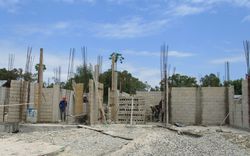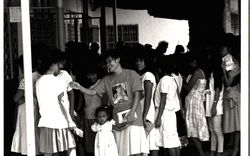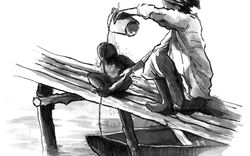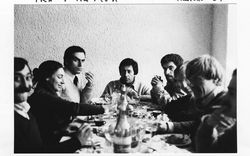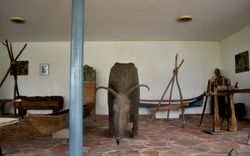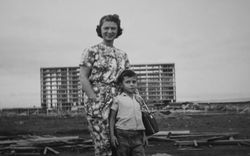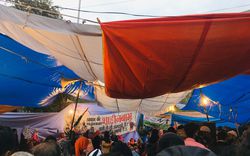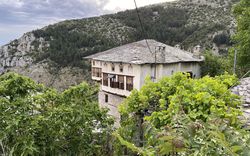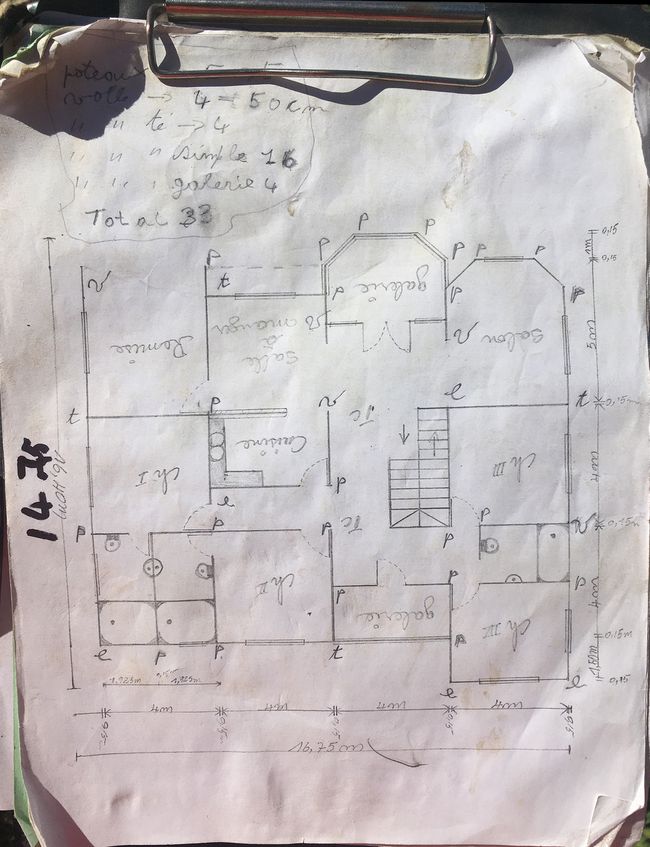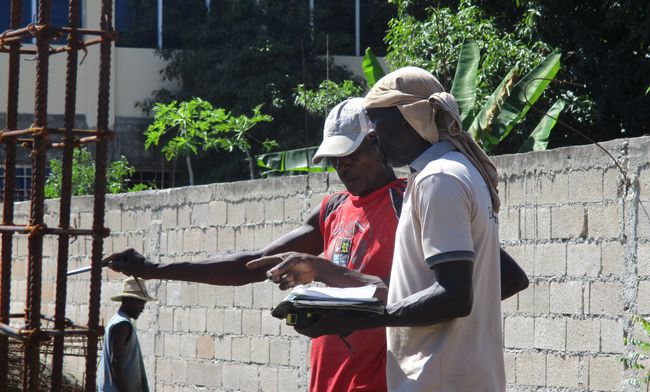Tracing a plan in Kreyòl
Irene Brisson narrates the process of creolization
(I draw [plans], but I don’t draw like an architect)
—Bòs Thomas
Writer and literary critic Édouard Glissant described creolization as an open process with unfixed outcomes, characterized by a dialectic between oral and written discourses.1 Kreyòl architecture, like that of a house in Leyogàn, results from such a dialectic process.2 In the narrative to follow, dialogue and images are transmitted through the hand-drawn plan into a Kreyòl architecture resultant from transnational encounters of people, technology, and media.
Bòs Thomas is a bòsmason (masonry contractor) who designed the house considered here under construction in the Gran Rivyè section of Leyogàn, Ayiti (Haiti).1 In an interview about his professional practice conducted as part of my dissertation research in 2017, Bòs Thomas described how his training prepared him to read floor plans and to trase or draw them, but he distinguished this from how an architect conceives of plans.2 Although he did not elaborate on what ineffable difference there was between his and an architect’s plan, a division in design and trade education is implicated. Nonetheless, in a building culture almost entirely dominated by concrete masonry block construction, it follows that bòsmasons come to function in many ways as architects in practice, if not in profession. Outside of some upper-class residential, commercial, and civic structures, most buildings in Haiti are built—and designed—by engineers, contractors, or homeowners. When they draw floor plans, they enact a Kreyòl architecture that weaves distributed and diverse influences together.
The house in question was commissioned by a diasporic client living in the United States.3 It was a typical mid-sized project for Bòs Thomas, who communicated with the client periodically by telephone, and with a local relative of the client who served as an intermediary for payments and who checked in on the work in progress. The program as defined by the client included four bedrooms, a kitchen and dining area, a garage, and a sitting room. A second-floor master suite was planned to be built by Bòs Thomas in a future phase of construction, presuming he would be available.
-
Bòs is a common honorific for a construction supervisor or tradesperson and in this case specifically a bòsmason or masonry contractor. ↩
-
Trase: Haitian Creole, verb, “to trace, draw, sketch,” and specifically, trase plan, is “to design, lay out [architecture]” in Valdman and Iskrova, Haitian Creole-English Bilingual Dictionary. ↩
-
Diaspora carries layers of signification both positive and negative for Haitians living in-country and abroad. In Create Dangerously (2011), Edwidge Danticat quotes writer Gérard Alphonse-Férère, “diaspora is a ‘term employed to refer to any dispersal of people to foreign soils.’ But in the Haitian context it is used ‘to identify the hundreds of thousands of Haitians living in many countries of the world.’” I use it intentionally here to signal the position of the client as a Haitian living abroad who intends to return to the house in question. ↩
Bòs Thomas integrated two sets of design parameters into the plans for the house. The first was the disposition of the requested number and types of rooms, while the second was the direction to build a house “like this,” with “this” in reference to illustrations of a suburban house model from a corporate home building company based in the US. The client sent two sheets with single-storey and two-storey versions, each with three facade variations. The fact that the reference was composed of multiple variations suggests a degree of flexibility in the client’s desire for similitude. The inclusion of both single- and two-storey models reflects the evolving image of the house, which would function first with one floor and eventually with two. Though the company provided schematic floor plans on their website, Bòs Thomas was only given the façade illustrations. The client communicated the idea of a desirable house through these images without attention to the arrangement of interior and exterior spaces nor to differences in construction systems.
It fell to Bòs Thomas to integrate the imagery of a US suburban home with a Haitian domestic program, infrastructure, and building culture. He translated certain formal features from the illustrations into the floor plan, including a covered entranceway flanked by columns and a bay in the sitting room with a large picture window. However, the light wood-framed model was rendered instead in concrete block. In tracing the plan, Bòs Thomas negotiated construction methods, cost estimating, space planning, and aesthetics—he designed a house. In executing the construction, implicit details were resolved in conversation with the foreman and construction crew, signaling an ad hoc approach to design and building characteristic of Kreyòl architecture. By defining Kreyòl architecture not as a particular creole style but as a process of creolization—“a limitless métissage, its elements diffracted and its consequences unforeseeable”1—practices of negotiating design ideas through various mediums, languages, and across national boundaries like those of Bòs Thomas come into relief.
-
Glissant, Poetics of Relation, 34. ↩
Bòs Thomas and his client were both born in Leyogàn and had both lived abroad. The client who commissioned the house was living in the United States and brought the aesthetics of US suburban housing to bear on his retirement home in Haiti. Bòs Thomas had lived and worked in Guadalupe where he learned his trade from a French engineer before returning to Haiti. Shortly after completing this project, he would return to Guadalupe to work in a more stable economic and political environment. Tracing these physical and conceptual trajectories through the design of a house reveals an ongoing process of creolization of domestic space. Technical, material, and aesthetic resources from North America and the Caribbean combine in Bòs Thomas’ Kreyòl architecture.


